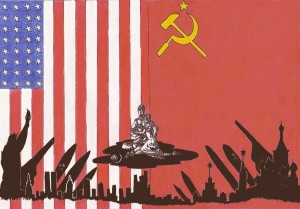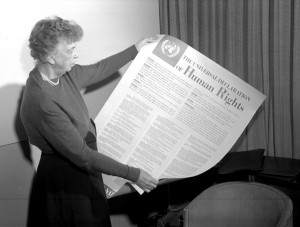
World History
For those who are looking for world history resources, we have gathered the following materials into topic-based clusters.
THE INDUSTRIAL REVOLUTION
Primary Sources:
Leeds Wollen Workers Petition: workers from a wool factory in Leeds, England petition for restrictions on the introduction and use of machines in the workplace, which they argue have been driving factory workers out of work.
Letter from Leeds Cloth Merchants: workers from a cloth factory in Leeds, England defend the use of machines, arguing that they are necessary to keep up with international competition.
On Power Looms: British inventor and writer William Radcliffe’s account of the origins of the power loom.
The Life of a Nineteenth Century Industrial Worker: excerpts from a parliamentary investigation of conditions in textile factories.
Japanese Workers Song: a Japanese workers’ song from the late 19th century.
Secondary Material:
Industrialization in Meiji Japan: This unit from MIT’s beautiful Visualizing Cultures website covers the Industrial Revolution in Japan and includes a comprehensive essay by John Dower, a stunning art gallery, and a curriculum outline complete with downloadable handouts and PowerPoints for students and teachers.
Global Industrialization Unit: a unit from Annenberg Learner’s Bridging World History page, which connects the industrial revolution in Europe to Cuba, Uruguay, and Japan. Includes a unit overview, three video segments, and three secondary readings.
The Industrial Revolution: Japan: a fantastic lesson plan for teachers on the Industrial Revolution in Japan from the Department of History at The University of California, Irvine.
The Industrial Revolution Outside the West: an article by historian Peter N. Stearns on the Industrial Revolution, with a brief introductory paragraph and a reflection question for students.
Industrialization and its Consequences, 1750-1914: a comprehensive resource from World History for Us All. Includes a full historical background essay for teachers and/or students and six teaching units with handouts, activities, and assessments.
Crash Course World History: The Industrial Revolution: an 11 minute overview of the Industrial Revolution, designed to capture the attention of high school students.
THE COLD WAR
Primary Sources:
Iron Curtain Speech: excerpts from Winston Churchill’s famous Iron Curtain Speech, March 5, 1946.
Stalin Responds to Iron Curtain Speech: Stalin responds to Churchill, accusing him of being a ‘firebrand of war’ and comparing him to Hitler.
The Long Telegram: American diplomat George F. Kennan’s famous telegram outlining his concept of ‘containment’. The telegram outlined what Kennan believed to the be ‘the Soviet Outlook,’ its effect on American security, and how he thought the United States should respond, namely, with a ‘policy of containment’.
Marshall Plan Speech: George Marshall gives a speech on the rationale behind his plan and why it is so crucial to European post-war recovery.
Soviet Statement of Friendship and Cooperation: a statement of friendship and cooperation between Russia and other socialist states made on October 30,1956, in the midst of the Hungarian Uprising.
Joseph McCarthy Speech on Communism: the speech that launched the era of McCarthyism.
John F. Kennedy Speech on Cuban Missile Crisis: Kennedy informs the public of the presence of Soviet missiles in Cuba.
Berlin Blockade CIA Summaries: CIA Summaries on the Berlin Blockade.
Khrushchev-Castro Letters Cuban Missile Crisis: a series of letters between Castro and Khrushchev during the Cuban Missile Crisis.
Secondary Material
Latin America and the Cold War: teaching unit on Latin America and the Cold War with a background essay, primary sources, key terms, and teaching activities.
Korean War: a brief 3 minute video from PBS on the Korean War, which brought the two world superpowers to the brink of a hot war on the Korean peninsula.
Paradoxes of Global Acceleration: a World History for Us All teaching unit on the Cold War period. Unit 9.2 focuses specifically on the Cold War conflict.
Latin America in the Cold War: a collection of resources from Yale’s Council on Latin American and Iberian Studies on Latin America in the Cold War including essays, PowerPoints, and teaching guides.
Crash Course World History: Cold War: a 12 minute overview of the Cold War by Crash Course World History on YouTube.
DECOLONIZATION & INDEPENDENCE
Primary Sources:
Declaration Granting Independence to Colonial Countries and Peoples: the UN Resolution granting independence to colonial countries and peoples, 1960.
Statute of Westminster: the Statute of Westminster, 1931, made all British ‘White Dominions’ sovereign nations.
Quit India Speeches: Gandhi’s Quit India speeches, encouraging civil disobedience and passive resistance in the name f Indian independence.
Vietnam Independence: the Vietnamese Declaration of Independence.
Korean Independence: links to the Korean Declaration of Independence on the Asia for Educators website. Includes reflection questions.
Secondary Material:
Background to Decolonization of Africa: a brief introduction to the decolonization of Africa, including a helpful chart of all African countries with independence dates, their previous colonial powers, their first heads of state, and wars of independence if applicable.
Nationalism and Social Change in Colonial Empires: a fantastic teaching unit by World History For Us All on nationalism and decolonization in colonial countries. Includes a complete downloading teaching unit covering India, Vietnam, Korea, and Kenya.
Colonial Identities: a Bridging World History Unit that uses clothing to look at colonial identities.
Human Rights and Decolonization: an article in Humanity Journal by Jan Eckel examining the way colonial countries used the rhetoric of human rights in their battles for independence.
HUMAN RIGHTS
Primary Sources:
Bill of Rights: British Bill of Rights from 1689.
Declaration of the Rights of Man and Citizen: the landmark human rights document from the the French Revolution.
Universal Declaration of Human Rights: the United Nations’ Universal Declaration of Human Rights from 1948.
Freedom Charter: South African document demanding certain basic rights and freedoms, 1955.
Charter 77: a then-illegal document criticizing the Czechoslovakian government for failing to implement many basic human rights guarantees.
Charter 08: a Chinese document from 2008, intending to “reiterate and endorse” basic universal values and push for further improvements in China.
Secondary Materials:
Check out some excerpts from the Constitutions of Bangladesh, Costa Rica, and Iran on human rights in their respective countries. The Teaching about Rights curriculum by the University of Texas offers a comparative teaching activity in which students compare the constitutions of various countries to each other (the Teaching about Rights curriculum includes a handy chart for this activity). Students could also compare these documents to the UN’s Universal Human Rights. You might also use Human Rights Watch’s website to explore current human rights issues and explain to students that the formal adoption of human rights documents does not always guarantee that these rights will be adopted in practice.
Amnesty International: Amnesty USA’s websites includes many resources for teaching about Human Rights, including complete lesson plans.
Gandhi Bio: a very brief biographical introduction to Gandhi.
 Institute for World History
Institute for World History


